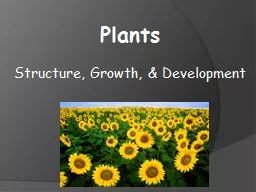

https wwwyoutubecomwatchvDGpPHrLF5M Plant Structure Introduction Parts of a Seed Seed Each seed contains a plant embryo Each seed also contains food for the embryo A tough outer case protects the embryo known as a seed coat ID: 758218
Download Presentation The PPT/PDF document "Plants Structure, Growth, & Develop..." is the property of its rightful owner. Permission is granted to download and print the materials on this web site for personal, non-commercial use only, and to display it on your personal computer provided you do not modify the materials and that you retain all copyright notices contained in the materials. By downloading content from our website, you accept the terms of this agreement.
Slide1
Plants Structure, Growth, & DevelopmentSlide2
https://www.youtube.com/watch?v=DGpPHrLF-5M
Plant Structure IntroductionSlide3
Parts of a SeedSlide4
SeedEach seed contains a plant embryo
Each seed also contains food for the embryo
A tough outer case protects the embryo, known as a seed coatSlide5
Parts of a SeedExternal seed coat Developing plant embryo
Stored food called endospermSlide6
Seed Dispersal
The main function of the
fruit
is to disperse the
seeds
Four
T
ypes:
Self dispersal
Wind
dispersal
Water
dispersal
Animal
dispersalSlide7
Seed DormancyEnsures that
the seed will germinate only when there are optimal
conditions
Plants stay dormant until the
right environmental conditionsSlide8
Seed GerminationSeeds do not always germinate right away; can
wait for
long periods of
time to
grow
Seed need
water, nutrients and the right temperature to
growSlide9
Order of Growth
embryonic
root, embryonic shoot,
leavesSlide10
Seed LabelingYou have 5 minutes to complete the diagramSlide11Slide12
https://www.youtube.com/watch?v=pQYJ2PSDu3A
Lima Bean DissectionSlide13
Plant Growth & TissueSlide14
MeristemsPlant cells that contain stem cells
Apical
meristems
Elongate
shoots and roots through primary growth
L
ocated
at the tips of roots and in the buds of
shoots
Lateral meristems
Add
thickness
of stems and roots
through secondary growthSlide15
Tissue SystemsDermal tissue system
Consists of the
epidermis
Ground tissue
V
arious
cells specialized
for:
Storage
Photosynthesis
S
upportSlide16
Three Tissue Systems: Dermal
, Vascular,
&
Ground
Each plant
organ has…
Dermal
, vascular, and ground tissues
Dermal
tissue
Ground
tissue
Vascular
tissueSlide17
Vascular TissueVascular
tissue system
Transport
of materials between roots and shoots
Xylem
Transports
water
upward
from roots into the
shoots
Phloem
Transports
nutrients
from where they are made to where they are neededSlide18
Vascular TissueSlide19
RootsSlide20
RootsRoot Structure
Apical meristem
N
ew cells along roots & stem; differentiate into other tissue
Root Cap
P
rotects root as it grows
Key role in water & mineral transportSlide21
RootsA
nchor
plants firmly in the
ground
A
bsorb
water and minerals
from
the
soil
Some roots
can
be
used
to grow a new plantSlide22
Types RootsFibrous roots
Multiple smaller roots
Tap roots
L
arge main central
rootSlide23
RootsAbsorption of water &
minerals near root tips
Large numbers of tiny root hairs increase the surface area of the root
Minerals use active
transportSlide24
Roots LabelingYou have 5 minutes to complete your roots diagramSlide25Slide26
StemsSlide27
StemsStructure
Produce leaves, branches, and flowers
Hold leaves up
Transport substance between roots and leaves
Transport systemSlide28
StemsXylem and phloem
M
ajor tubule systems
Transport water
&
nutrients
Nodes
Attachment for leaves
Internodes = stem between nodes
Petiole
“Stem” of the leafSlide29
Types of Stems
Woody
Thick cell walls
Trees, shrubs, and vines
Herbaceous
Supported by hydrostatic pressure (turgor)
Dandelions, zinnias, petunias
Slide30
Underground StemsTuborsUsed to store food for the plantBulbsAllows the plant to be dormant
with cold temperature
Rhizome
H
orizontal
underground
stem = produces shoot and
root systems
of a new
plantSlide31
StemsLenticles
Pore in the stem
providing
direct
gas exchange
Buds
U
ndeveloped
shoot from which embryonic leaves or flower parts ariseSlide32
Transport in PlantsCapillary action
Tendency
of water to rise in a thin
tube
Adhesion & cohesionSlide33
LeavesSlide34
LeavesSight of photosynthesis
Anatomy
Cuticle – covers and protects leaf
Blade
– thin flattened section
Petiole – stalk that attaches stem to blade
Covered by epidermis and cuticle
Create water proof barrierSlide35
Mesophyll & Stomata
Mesophyll
– site of photosynthesis
Palisade mesophyll – absorb light
Spongy mesophyll
– air space for gas diffusion
Stomata – pores on the underside of the leaf
CO2 enters
O2 + H2O
exit
Most active during the day
Guard Cells –
open and close stomataSlide36
Leaf AdaptationsExcess of
Sunlight
Thick cuticle
Small/narrow leaves
Limited Sunlight
Thin cuticle
Large/broad leavesSlide37
Transport & TropismsSlide38
Transport in PlantsTranspiration
Osmotic pressure moves water out of vascular tissue
This pulls water up from the stem to the leaves
Affected by heat, humidity, windSlide39
GravityResponse to gravity is
gravitropism
Roots show positive
gravitropism
Stems show negative
gravitropismSlide40
HydrotropismRoots grow toward water (positive)Slide41
Thigmotropism
Growth in response to touch
Plant
grows toward
(+) or
away from (-) pressure
Vines
and other climbing
plantsSlide42
Thermotropism
Plant response to temperature
‘
HEAT’Slide43
Phototropism
Plants grow toward a
source
of light
Tropisms
https://www.youtube.com/watch?v=pCFstSMvAMISlide44
Plant HormonesSlide45
Plant Hormones & Tropisms
Hormones
Chemical
signals that coordinate growth, development, and responses to
stimuli
Tropisms
are often caused by hormonesSlide46
Auxin
Any
chemical substance that promotes cell elongation
(growth) in
different target
tissues
Formation & branching
of
rootsSlide47
GibberellinsStem
elongation (growth)
Fruit growth
Seed germinationSlide48
CytokininsStimulate
cell division
Found in actively
growing tissues Slide49
Ethylene“Aging” hormone
Causes fruits to ripen